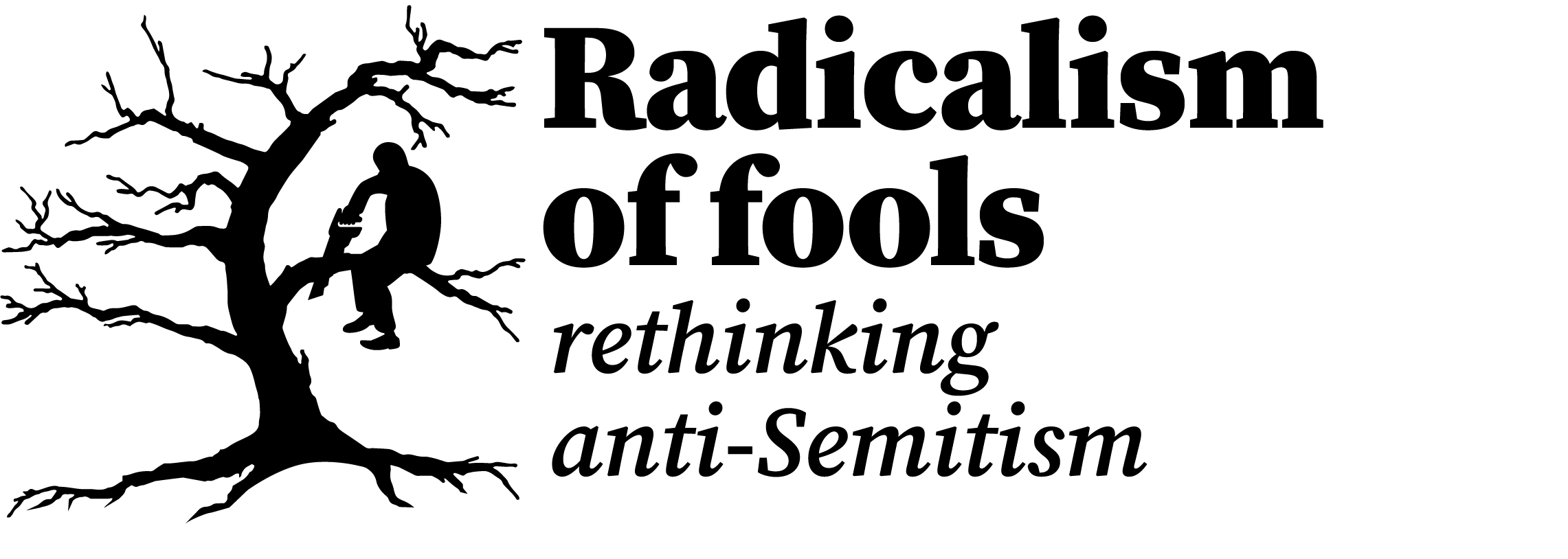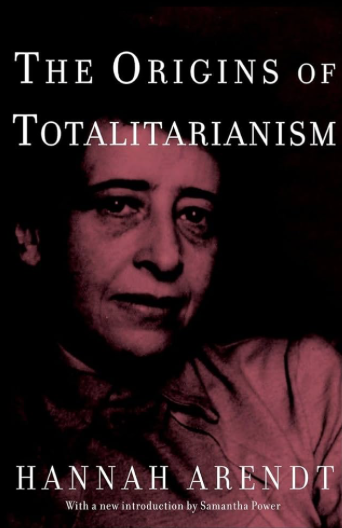Hannah Arendt, arguably the greatest political thinker of the twentieth century, devoted the first part of her masterwork on The Origins of Totalitarianism (1951) to anti-Semitism. Her stated goal was to explain how such a small phenemonon could become a “catalytic agent” for the greatest catastrophes of the era.
Anti-Semitism had been central to Nazi totalitarian ideology. Hitler had portrayed the Jewish people in similar terms to The Protocols of the Elders of Zion, a notorious tsarist forgery, first published in about 1903 ( accounts vary on the exact date). The Protocols claimed to have discovered the plot of Jewish world domination. It blamed Jews for every major destabilising event starting with the French Revolution. Hitler updated the fantasy to include Jewish responsibility for the Russian Revolution, the Weimar Republic (1918-33) and the two world wars.
Arendt insisted that it was essential to understand how this anti-Semitic fiction could have been believed by so many people. She said it contributed to driving the Jews “into the storm center” of 20th-century events (p7). One of the obstacles to understanding this, she said, was the ahistorical and “fallacious” notion of eternal anti-Semitism. That is, she said: “an unbroken continuity of persecutions, expulsions, and massacres from the end of the Roman Empire to the Middle Ages, the modern era, and down to our own time, frequently embellished by the idea that modern antisemitism is no more than a secularized version of popular medieval superstitions.” (p3)
Many people who write about contemporary anti-Semitism fall into the trap of the eternal anti-Semitism fallacy. For example, Jake Wallis Simons includes the notion of “the oldest hatred” in the sub-title of Israelophobia (2023), his widely acclaimed book. He interprets hatred of Israel, and all other manifestations of hatred towards Jews, as different manifestations of the same old antipathy.
Wallis Simons makes the very mistake Arendt warned against. Anti-Semitic tropes are recycled from ancient and medieval Christian times (from the conspiracy of world domination to blood libel and ritual murder), resurfacing through the ages. It is therefore easy to see reflected in them the same old hatred that was undoubtedly ingrained in Europe’s Christian heritage. As he says, in unwitting opposition to Arendt: “However secular a society becomes it continues to be influenced by the old Christian psychodrama”(p20).
Arendt notes that the similarity between this past and present imagery gives credence to the notion of eternal anti-Semitism. But, as she shows through her historical approach, the content of modern anti-Semitism has little to do with the earlier Christian religious hatred. Or any other previous forms of Jew hatred for that matter. It is a different phenomenon that emerged in the late 19th century with the term coined shortly beforehand. It was, according to Arendt, a “secular political ideology”. She argued it “must be seen in the more general framework of the development of the nation-state, and at the same time its source must be found in certain aspects of Jewish history and specifically Jewish functions during the last centuries” (p19).
Arendt’s historical analysis is perhaps unique among the many attempts to understand the rise of modern anti-Semitism. She saw three specific features in her analysis. First, it applied to a specific period in European history. That was from the emergence of the modern nation-state up to its decline in the age of imperialism (17th – early 20th century). Second, it referred to a particular area of Europe – western and central Europe. This was where Jews were mostly assimilated following their gradual emancipation in the 19thcentury. Finally, a small group of wealthy Jews who, although only a minority came to be seen as representative of all Jews. That was in contrast to most of European Jewry which lived in impoverished conditions completely unassimilated into the societies where they lived.
By exploring the relationship between this small minority of wealthy Jews, the nation-state and society, Arendt showed how the anti-Semitic conspiracy theory could be credible. The partial truth that gave plausibility to the fantasy, lay in the history of this particular group of Jews and their relationship to the nation-state.
But when the new phenomenon of political anti-Semitism arose, the material basis had almost completely vanished. Political anti-Semitism was no longer about real living Jews or real conflicts of interest in society. One of its distinctive features was that it was detached from reality and could be used as a political tool.
To understand how political anti-Semitism arose just when the financial influence of wealthy Jews declined, Arendt looked at their function in the development of nation-states. She outlined four historical periods:
1. The age of Enlightenment. In the 17th and 18th centuries, the modern nation-states developed under the absolute monarchs. Only individual wealthy Jews were willing to finance them. As a result, with their experience of money-lending, they became court Jews who financed the many statelets in the region. Such Jews gained positions of influence and received special privileges and protection in return for their financial services.
2. After the French Revolution of 1789: In the late 18th to the mid-19th century, the nation-states, either constitutional monarchies or republics, needed increasing amounts of finance to fund their expanding governments. The combined wealth of moneyed inter-European Jews (probably 100 families in total) was enlisted. The Rothchild banking family was a prominent example. It is important to note that all Jewish people came to be seen as an international wealthy caste.
3. The age of imperialism. From the late 19th to early 20th century (1884–1914), the nation-state as an entity within national borders was undermined by the imperialist project. Limitless expansion across the globe became the norm. Wealthy Jews of western and central Europe began to lose their exclusive role in the nation-states. Instead the national bourgeoise began to take an interest in financing their governments’ imperialist enterprise.
4. The triumph of imperialism and the disintegration of the nation-state: This period covers the start of the First World War (1914) to the “Final Solution”, the Nazis’ euphemism for the genocide of Jews in the Second World War. By this time, the fully assimilated western and central European Jews had little presence in European finance, contrary to popular belief. As Arendt says about Germany, the German banks were almost judenrein (free of Jews).
The above outlines the rise and decline of the nation-state and the parallel trajectory of the wealthy Jewish financers within it. Their close connection to the state gave rise to the myth of secret Jewish power behind governments, influencing the course of world events. However, Arendt makes the point that, contrary to this fantasy, the Jewish financiers never competed for political power themselves. They posed no threat to the states they financed (p36-37). But using an insight borrowed from Alex de Tocqueville, a 19th French political thinker, Arendt shows how this loss of influence had dangerous consequences. Wealth without power left the wealthy exposed as parasites and unleashed intense feelings of resentment, hatred and revulsion.
Arendt makes another useful generalisation that show the consequences of this part of Jewish history with its intimate connection to the state. When social strata or classes in society come into conflict with the state, they see themselves in conflict with Jews. And so antagonism against the government was also antagonism against the Jews.
As Arendt deepened her analysis it increased in originality. The phenomenon of modern political anti-Semitism had two variants: pre-totalitarian and totalitarian. She implies that these variants would not have been so virulent if they were not built on a social prejudice. It had existed ever since Jews had attempted to assimilate into society following their emancipation from the early 19th century (p38). That enabled them to be used as a political tool. By the beginning of the 20th century, this social antipathy towards Jews pervaded all classes in European societies.
In Arendt’s distinction between pre- and totalitarian political anti-Semitism, she challenges our long-held beliefs. The anti-Semitism that predated Nazism (pre-totalitarian) was thoroughly national. She exemplifies this through a detailed discussion of the Dreyfus affair in France (when Alfred Dreyfus, a Jewish army captain was found guilty of treason on trumped-up charges and sentenced to life imprisonment).
The “totalitarian” variant of anti-Semitism, exemplified by the Nazi movement, was consistently supranational despite the Nazis’ ultra-nationalist propaganda – which was for public consumption.
Both variants were violent but the pre-totalitarian variant, despite the calls for “death to the Jews” heard in France during the Dreyfus affair, was not genocidal. It wanted foreigners, that is, Jews, out of the French nation, rather than their extermination. Arendt saw this variant as only a “foregleam” of things to come. It sat firmly within the national framework. The totalitarian variant, however, was a supranational movement related to imperialism. With its global expansion beyond national borders it demanded the extermination of Jewry throughout the world rather than just their expulsion from the nation. The fact that Nazism was not ultra-national but supranational is one of Arendt’s most insightful and ignored observations.
To sum up, Arendt thought that modern anti-Semitism had to be understood within the historical context of the development and disintegration of the nation-state. Political anti-Semitism needed to be understood as an ideology emerging at a time when the portrayal of Jews as depicted in the Protocol of Elders of Zion bore no resemblance to the reality which had existed albeit in a tenuous and distorted form. It was a new phenomenon, consisting of two variants, pre-totalitarian and totalitarian. The latter was particularly deadly and could not have emerged without the triumph of imperialism and its racist ideology.
For this reason, the religious hatred of Jews that existed for millenia prior to the emergence of the nation-state is of little relevance to modern anti-Semitism. The main danger of the fallacy of eternal anti-Semitism is that it offers no tools with which to understand anti-Semitism. It encourages a fatalistic view that anti-Semitism is a normal and inevitable part of life for Jews living among non-Jews.
A lot has happened in relation to anti-Semitism since Arendt’s death in 1975. This includes the consolidation of an unhinged hostility to Israel, the rise of Islamism as a global force and the emergence of identity politics. Arendt could not have fully anticipated all these developments but her ideas help provide a superior approach to understanding anti-Semitism. Not as a timeless hatred but rather as a flawed world view informed by a specific set of circumstances.
Arendt addressed the question of why the fantastical Protocols of the Elders of Zion “is believed by so many people that it can become the text of a whole political movement” (p16). Today it is more essential than ever to answer this question.
Stefanie Borkum completed her PhD in 2018 and after that vowed never to write anything longer than book reviews.The page references in this article are to the Shocken edition published in 2004.
The views expressed in this article do not necessarily reflect those of the Radicalism of fools project.

